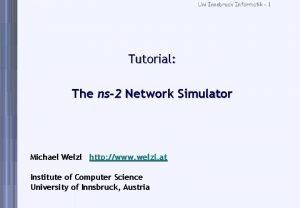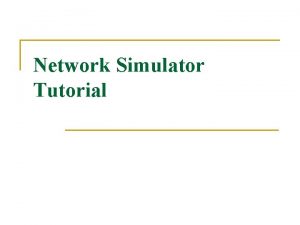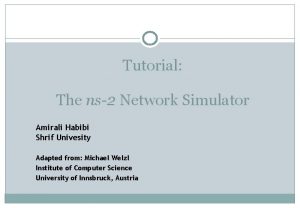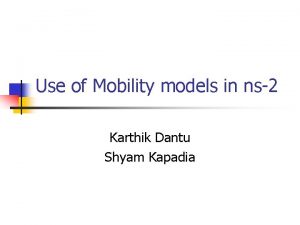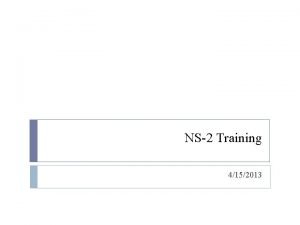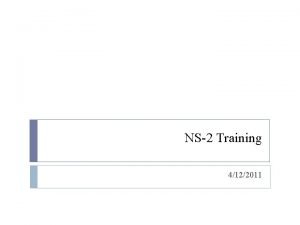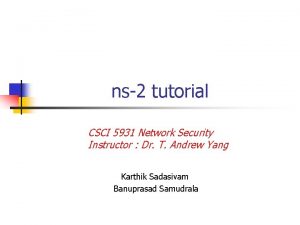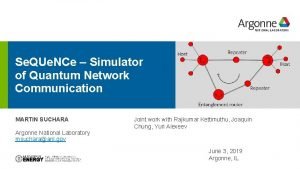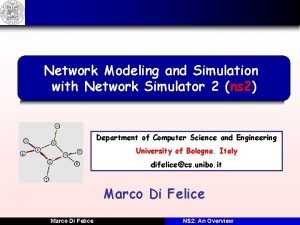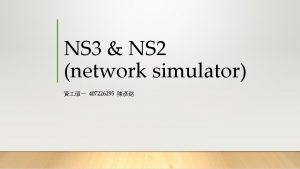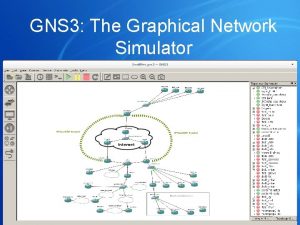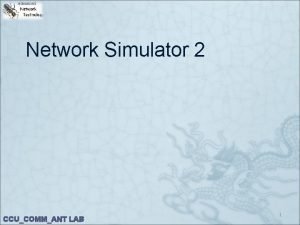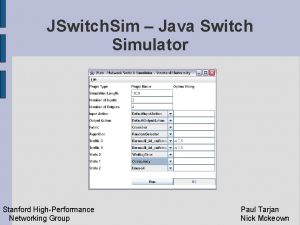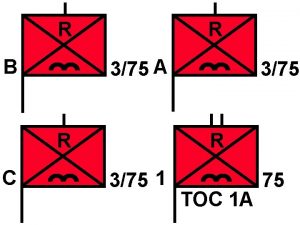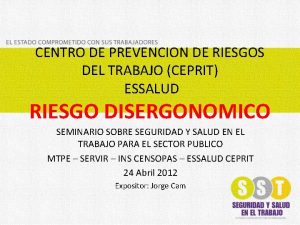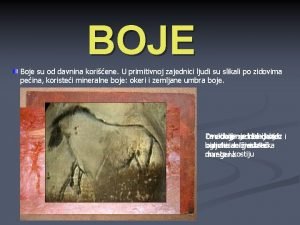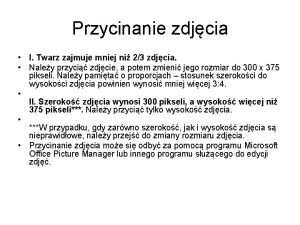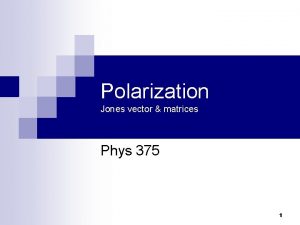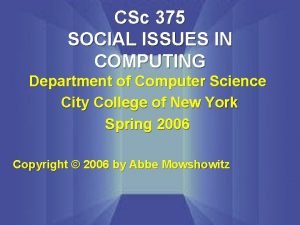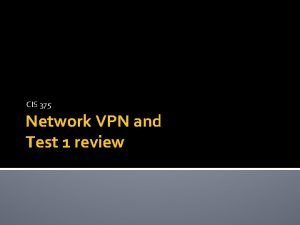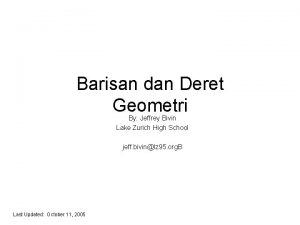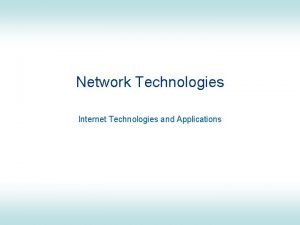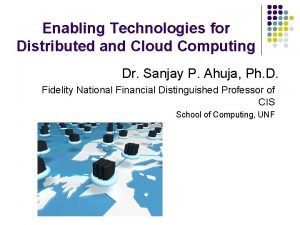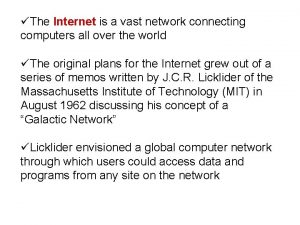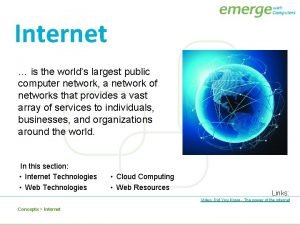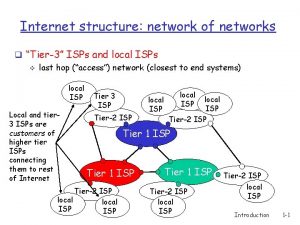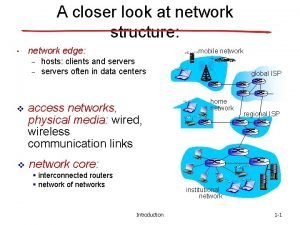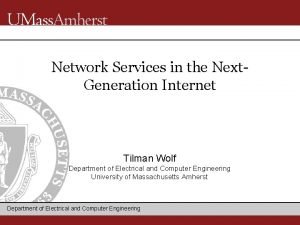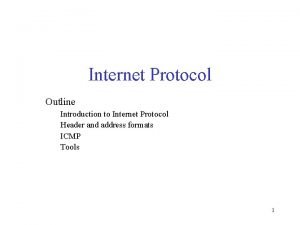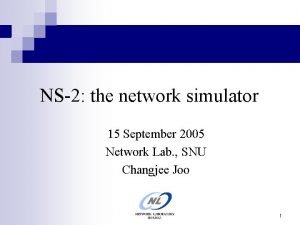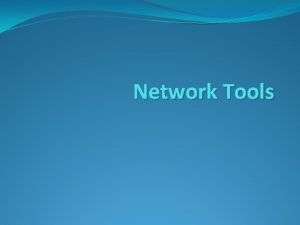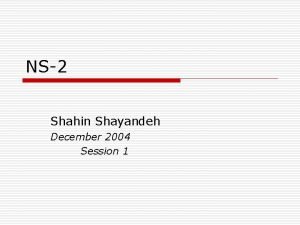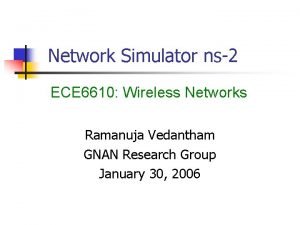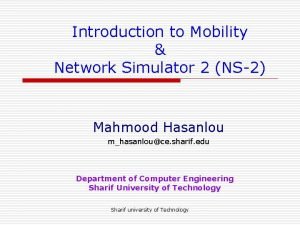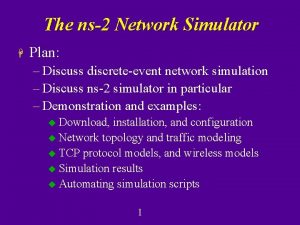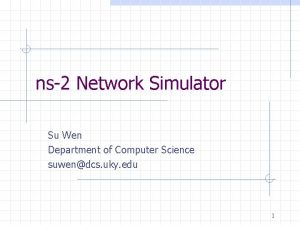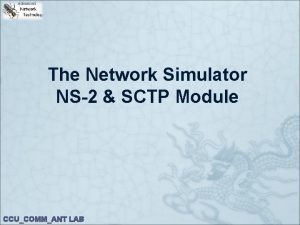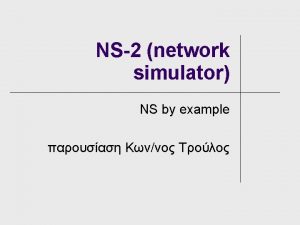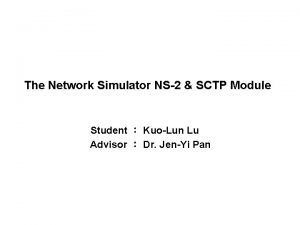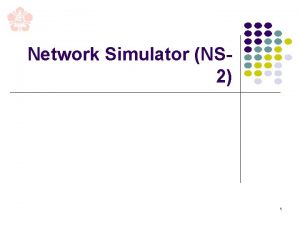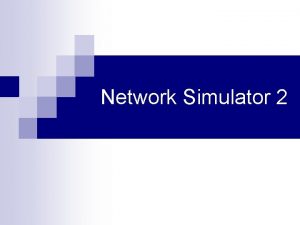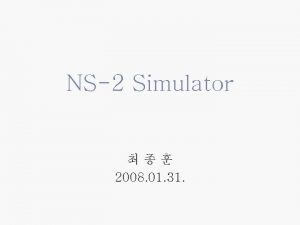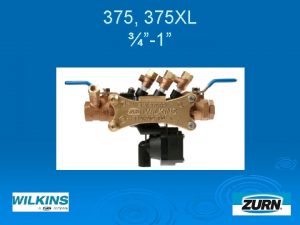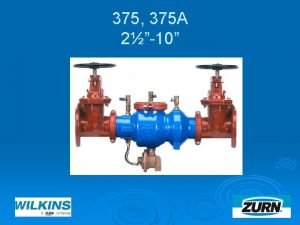Network Simulator NS2 Internet Technologies 60 375 Varaprasad












![NS-2 Environment Simulation Scenario 1 2 set ns_ [new Simulator] Tcl Script set node_(0) NS-2 Environment Simulation Scenario 1 2 set ns_ [new Simulator] Tcl Script set node_(0)](https://slidetodoc.com/presentation_image_h/9e4ee7b58a8d1837f3ffd5336f5d093d/image-13.jpg)




























![Generating Traffic n Attaching Application (FTP) ¨ set FTP 0 [new Application/FTP] ¨ set Generating Traffic n Attaching Application (FTP) ¨ set FTP 0 [new Application/FTP] ¨ set](https://slidetodoc.com/presentation_image_h/9e4ee7b58a8d1837f3ffd5336f5d093d/image-42.jpg)


- Slides: 44

Network Simulator (NS-2) Internet Technologies 60 -375 © Varaprasad Reddy

Agenda n n n n Overview of NS-2 History Current Status Platforms Supported Discrete Event Simulator NS-2 Environment NS-2 Hierarchy NS-2 Architecture ¨ ¨ ¨ n Node Architecture Multicast Node Architecture Packet Structure Links Traffic Flow Example © Varaprasad Reddy 2

Overview of NS-2 n n n Discrete Event Simulator Packet level Modeling Network protocols ü Collection of Various protocols at multiple layers ü ü ü TCP(reno, tahoe, vegas, sack) MAC(802. 11, 802. 3, TDMA) Ad-hoc Routing (DSDV, DSR, AODV, TORA) Sensor Network (diffusion, gaf) Multicast protocols, Satellite protocols, and many others © Varaprasad Reddy 3

Overview of NS-2 Maintained through VINT project n NS 2 : collaborative simulation environment n ü Freely distributed and open source ü Supports NT research and education ü Protocol design , traffic analysis etc. ü Provides common reference © Varaprasad Reddy 4

History 1995 : Developed by LBL through support of DARPA n 1996: NS was extended and distributed by VINT project n 1997: Satellite models added @ UCB n 1999: Wireless models added @ CMU n Recent incorporation of emulation n © Varaprasad Reddy 5

Current status n Releases: ü Periodic releases (currently 2. 27, Jan 2004) ü Daily snapshots (probably compiles and works, but “unstable”) ü Available from: USC/ISI, UC Berkeley, UK mirror ü More than 10 k users from hundreds of univs © Varaprasad Reddy 6

Platforms supported n Most UNIX and UNIX-like systems Free. BSD ü Linux ü Solaris ü n Windows 98/2000/2003/XP ¨ Cygwin required ¨ Some work , some doesnt © Varaprasad Reddy 7

NS-2 : Components n n NS – Simulator NAM – Network Ani. Mator ¨ n visual demonstration of NS output Preprocessing ¨ Handwritten TCL or ¨ Topology generator n Post analysis ¨ Trace analysis using Perl/TCL/AWK/MATLAB © Varaprasad Reddy 8

User’s Perspective n From the user’s perspective, NS− 2 is an OTcl interpreter that takes an OTcl script as input and produces a trace file as output. © Varaprasad Reddy 9

Discrete event simulator n ns-2 is an discrete event driven simulation Physical activities are translated to events ¨ Events are queued and processed in the order of their scheduled occurrences ¨ Time progresses as the events are processed ¨ Time: 1. 5 sec Time: 1. 7 sec 2 1 Time: 2. 0 sec Time: 1. 8 sec © Varaprasad Reddy 10

Discrete Event Scheduler time_, uid_, next_, handler_ head_ -> handler_ -> handle() insert time_, uid_, next_, handler_ Event Scheduler © Varaprasad Reddy 11

Event Scheduler n Non-Real time schedulers ¨ Implementations : List ¨ Calender is default n Real time schedulers ¨ Used n , Heap , Calender for emulation for direct interaction with real NT. Basic use of an event scheduler: ¨ schedule simulation events, such as when to start an FTP application, when to finish a simulation, or for simulation scenario generation prior to a simulation run. © Varaprasad Reddy 12
![NS2 Environment Simulation Scenario 1 2 set ns new Simulator Tcl Script set node0 NS-2 Environment Simulation Scenario 1 2 set ns_ [new Simulator] Tcl Script set node_(0)](https://slidetodoc.com/presentation_image_h/9e4ee7b58a8d1837f3ffd5336f5d093d/image-13.jpg)
NS-2 Environment Simulation Scenario 1 2 set ns_ [new Simulator] Tcl Script set node_(0) [$ns_ node] set node_(1) [$ns_ node] C++ Implementation class Mobile. Node : public Node { friend class Position. Handler; public: Mobile. Node(); • • } © Varaprasad Reddy 13

tcl Interpreter With Extents Event Scheduler otcl 8. 0 Network Component tclcl ns-2 otcl: Object-oriented support n tclcl: C++ and otcl linkage n Discrete event scheduler n Data network (the Internet) components n © Varaprasad Reddy 14

NS-2 Hierarchy © Varaprasad Reddy 15

NS-2 Hierarchy © Varaprasad Reddy 16

NS-2 Directory Structure sim tcl 8. 0 tk 8. 0 otcl Tcl ns-2 tcl code nam-1 C++ code . . . tcl example ex test validation test © Varaprasad Reddy lib . . . tcl code core 17

Node Architecture Node Agent Classifier Node entry point Addr Classifier Local Agent Port Classifiers: packet demultiplexers. Link Agents are either protocol endpoints or related © Varaprasad Reddy objects that generate/fill-in packet fields. Link 18

Multicast Node architecture © Varaprasad Reddy 19

Packets. Packet (events) Structure packet Size determined at simulation config time next_ accessdata( ) bits( ) - packet size Size determined at compile time © Varaprasad Reddy cmn header tcp header - timestamp - type - UID - interface label ip header trace header 20

Links: keeps track of “from” and “to” node objects. blocked Link entry point Enq Trace Queue Deq Trace Drop head Drp Trace Delay © Varaprasad Reddy TTL Rcv Trace 21

N 1 N 2 Node Application Classifier Port Local Agent Classifier Local Port Agent Application Addr Link Enq Trace Queue Link Drop head Deq Trace Delay TTL Rcv Trace Drp Trace © Varaprasad Reddy 22

NS-2 : C++ / OTCL NS-2 Code contains two sets of languages, namely C++ and OTcl. n C++ is used for the creation of objects because of speed and efficiency. n OTcl is used as a front-end to setup the simulator, configure objects and schedule events because of its ease of use. n © Varaprasad Reddy 23

Why two languages? (Tcl & C++) n C++: Detailed protocol simulations require systems programming language ¨ byte manipulation, packet processing, algorithm implementation ¨ Run time speed is important ¨ Turn around time (run simulation, find bug, fix bug, recompile, re-run) is slower n Tcl: Simulation of slightly varying parameters or configurations ¨ quickly exploring a number of scenarios ¨ iteration time (change the model and re-run) is more important © Varaprasad Reddy 24

Tcl or C++? n Tcl ¨ Simple Configuration, Setup, Scenario ¨ If it’s something that can be done without modifying existing Tcl module. n C++ ¨ Anything that requires processing each packet ¨ Needs to change behavior of existing module © Varaprasad Reddy 25

Shadowing Tcl. Object OTcl class hierarchy C++ class hierarchy Tcl. Object() Agent() Agent/DSDVAgent() Agent/DSDV OTcl shadow object Agent/DSDV C++ object © Varaprasad Reddy 26

Object Correspondence Agent/DSDV Constructor Agent Constructor Tcl. Object Constructor Invoke parent Create C++ init complete OTcl shadow TCL C++ Tcl. Object() Constructor Agent. DSDV() Constructor Do nothing, Invoke parent return bind and return © Varaprasad Reddy 27

Outline © Varaprasad Reddy 28

NS-2 Directory Structure sim tcl 8. 0 tk 8. 0 otcl Tcl ns-2 tcl code nam-1 C++ code . . . tcl example ex test validation test © Varaprasad Reddy lib . . . tcl code core 29

Making Changes in C++ Space n Existing code ¨ recompile n Addition ¨ change Makefile and recompile © Varaprasad Reddy 30

Making Changes in otcl Space n Existing code ¨ recompile ¨ source n Addition ¨ source ¨ change Makefile (NS_TCL_LIB), tcl/nslib. tcl (source) and recompile © Varaprasad Reddy 31

Installation n Unix variants ¨ Download NS-allinone-2. 27 package ¨ Contains TCL/TK 8. 4. 5 n o. TCL 1. 8 n Tclcl 1. 15 n Ns 2 n Nam -1 n © Varaprasad Reddy 32

Installation ¨ After successful downloading and unzipping install allinone package , install NS by n install by calling ~/ns-allinone-2. 27/install After successful installation , Validate the scripts by running. /validate in ~/ns-allinone 2. 27/ns-2. 27/ ¨ Its now all set to work with NS ¨ © Varaprasad Reddy 33

Code for simple topology n Creating a Simulator Object ¨ set n ns [new Simulator] Setting up files for trace & NAM ¨ set trace_nam [open out. nam w] ¨ set trace_all [open all. tr w] n Tracing files using their commands ¨ $ns namtrace-all $trace_nam ¨ $ns trace-all $trace_all © Varaprasad Reddy 34

Code for simple topology n Closing trace file and starting NAM ¨ proc finish { } { global ns trace_nam trace_all n $ns flush-trace n close $trace_nam n close $trace_all n exec nam out. nam & n exit 0 } n © Varaprasad Reddy 35

Code for simple topology n Creating LINK & NODE topology ¨ Creating NODES set n 1 [$ns node] n set n 2 [$ns node] n set n 3 [$ns node] n set n 4 [$ns node] n set r 1 [$ns node] n set r 2 [$ns node] n © Varaprasad Reddy 36

Code for simple topology n Creating LINKS ¨ ¨ ¨ ¨ ¨ $ns duplex-link $N 1 $R 1 2 Mb 5 ms Drop. Tail set Duplex. Link 0 [$ns link $N 1 $R 1] $ns duplex-link $N 2 $R 1 2 Mb 5 ms Drop. Tail set Duplex. Link 1 [$ns link $N 2 $R 1] $ns duplex-link $R 1 $R 2 1 Mb 10 ms Drop. Tail set Duplex. Link 2 [$ns link $R 1 $R 2] $ns duplex-link $R 2 $N 3 2 Mb 5 ms Drop. Tail set Duplex. Link 3 [$ns link $R 2 $N 3] $ns duplex-link $R 2 $N 4 2 Mb 5 ms Drop. Tail set Duplex. Link 4 [$ns link $R 2 $N 4] © Varaprasad Reddy 37

Code for simple topology n Orientation of links $ns duplex-link-op $N 1 $R 1 orient right-down ¨ $ns duplex-link-op $N 2 $R 1 orient right-up ¨ $ns duplex-link-op $R 1 $R 2 orient right ¨ $ns duplex-link-op $R 2 $N 3 orient right-up ¨ $ns duplex-link-op $R 2 $N 4 orient right-down ¨ © Varaprasad Reddy 38

Final topology Generated © Varaprasad Reddy 39

Traffic topology aimed at © Varaprasad Reddy 40

Generating Traffic n Attaching AGENT TCP to NODE 1 ¨ ¨ n Attaching AGENT TCP to NODE 2 ¨ ¨ n set TCP 2 [new Agent/TCP] $ns attach-agent $N 2 $TCP 2 Attaching AGENT TCP to NODE 3 ¨ ¨ n set TCP 1 [new Agent/TCP] $ns attach-agent $N 1 $TCP 1 set TCP 3 [new Agent/TCPSink] $ns attach-agent $N 2 $TCP 3 Attaching AGENT TCP to NODE 4 ¨ ¨ set TCP 4 [new Agent/TCPSink] $ns attach-agent $N 2 $TCP 4 © Varaprasad Reddy 41
![Generating Traffic n Attaching Application FTP set FTP 0 new ApplicationFTP set Generating Traffic n Attaching Application (FTP) ¨ set FTP 0 [new Application/FTP] ¨ set](https://slidetodoc.com/presentation_image_h/9e4ee7b58a8d1837f3ffd5336f5d093d/image-42.jpg)
Generating Traffic n Attaching Application (FTP) ¨ set FTP 0 [new Application/FTP] ¨ set FTP 1 [new Application/FTP] ¨ $FTP 0 attach-agent $TCP 0 ¨ $FTP 1 attach-agent $TCP 1 © Varaprasad Reddy 42

Setting simulation times $ns at 0. 5 "$FTP 0 start" n $ns at 0. 5 "$FTP 1 start" n $ns at 10. 0 "$FTP 0 stop" n $ns at 10. 0 "$FTP 1 stop“ n $ns at 10. 0 “finish” n Making NS run n ¨ $ns run © Varaprasad Reddy 43

© Varaprasad Reddy 44
 Innsbruck uni
Innsbruck uni Ns2 simulator tutorial
Ns2 simulator tutorial Ns2 simulator tutorial
Ns2 simulator tutorial Karthik dantu
Karthik dantu Awkweb
Awkweb Awk ns2
Awk ns2 Ns2 tutorial
Ns2 tutorial Quantum network simulator
Quantum network simulator Network simulator 2
Network simulator 2 Onap network slicing
Onap network slicing Network slicing simulator
Network slicing simulator Ns3 network simulator
Ns3 network simulator What is gns in networking
What is gns in networking Network simulator 2 download
Network simulator 2 download Benchmarksim
Benchmarksim Arc375
Arc375 Rm 375-tr-2008 iluminacion tabla
Rm 375-tr-2008 iluminacion tabla Berlinsko plavo
Berlinsko plavo 300 x 375 pikseli
300 x 375 pikseli Com(2018) 375 final
Com(2018) 375 final Sphere of influence imperialism examples
Sphere of influence imperialism examples Waveplate jones matrix
Waveplate jones matrix Ludlum 375
Ludlum 375 Csc 375
Csc 375 Cis 375
Cis 375 Deret geometri formula
Deret geometri formula Internet technologies and applications
Internet technologies and applications Technologies for network based systems
Technologies for network based systems Internet or internet
Internet or internet Vast network
Vast network The internet is the world's largest computer network
The internet is the world's largest computer network Intranet advantages and disadvantages
Intranet advantages and disadvantages Internet
Internet International networking adalah
International networking adalah Internet structure network of networks
Internet structure network of networks Internet structure network of networks
Internet structure network of networks Internet international network
Internet international network Network as a service for next generation internet
Network as a service for next generation internet Protocol outline
Protocol outline Virtual circuit tables
Virtual circuit tables What is topology in computer
What is topology in computer Features of peer to peer network and client server network
Features of peer to peer network and client server network Ece 526
Ece 526 Network centric computing and network centric content
Network centric computing and network centric content Packet switched vs circuit switched
Packet switched vs circuit switched
